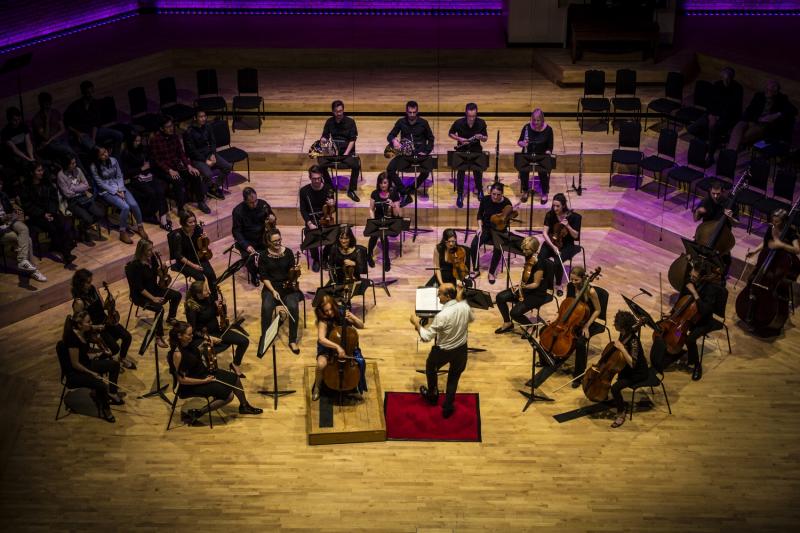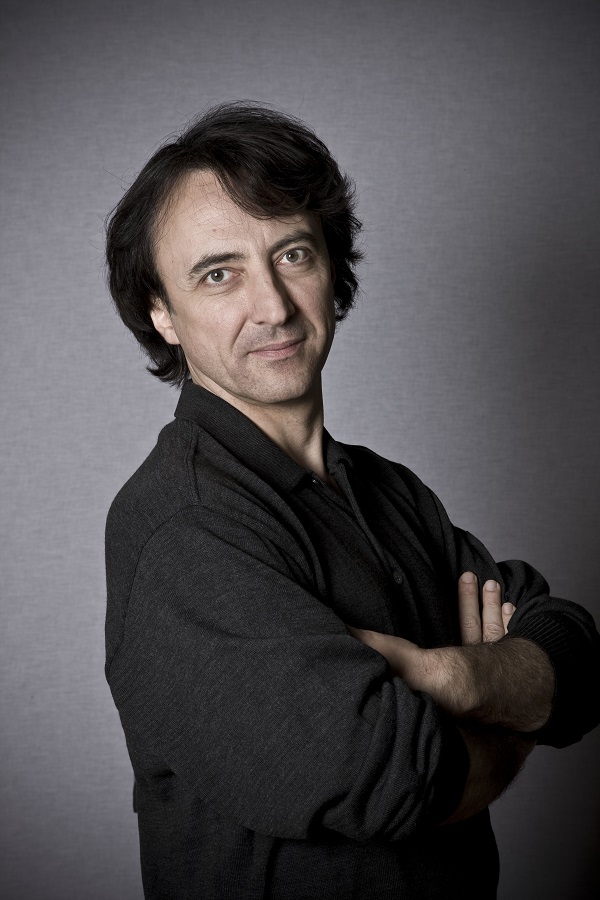Bavouzet, Manchester Camerata, Takács-Nagy, RNCM, Manchester | reviews, news & interviews
Bavouzet, Manchester Camerata, Takács-Nagy, RNCM, Manchester
Bavouzet, Manchester Camerata, Takács-Nagy, RNCM, Manchester
Mozart the old-fashioned – and highly musical – way

Manchester Camerata give relatively few old-fashioned concerts these days – I mean the sort that are done in purpose-built concert halls, with a conductor, soloist and conventional orchestra strength – because they’re busy crossing boundaries and attracting new audiences. But when they do return to the traditional path, they do it extremely well, and especially when music director Gábor Takács-Nagy is in charge.
This time, at the Royal Northern College of Music, there was the additional distinction of Jean-Efflam Bavouzet as soloist in two Mozart piano concertos. He and they have recorded Nos. 17 and 18 already for Chandos, and this concert was part of the process for their next CD, of Nos. 14 and 19. They are combining the concertos with the "Salzburg Divertimenti" which the extraordinary Wolfgang created at the age of 15 – sometimes played as string quartets, but sounding fantastic done by a string chamber orchestra of 22 players.
 Gábor Takács-Nagy (pictured right) lavished as much care on the Divertimento in D (K136) as others might on a full-blown symphony. Announcing at the outset his intention to make his audience smile as they heard the music, he did the same himself and inspired the musicians to play likewise. There are delightful contrasts of theme and echo in the writing, and he was alive to them all (especially the fade-away ending of the repeat of the first part of the opening movement). The Andante (like a stately sarabande in this performance) showed meticulous preparation in each phrase and revealed beauty in every one. The Presto was joyous in its fugal effervescence, zippy in tempo and vital in its contrasts.
Gábor Takács-Nagy (pictured right) lavished as much care on the Divertimento in D (K136) as others might on a full-blown symphony. Announcing at the outset his intention to make his audience smile as they heard the music, he did the same himself and inspired the musicians to play likewise. There are delightful contrasts of theme and echo in the writing, and he was alive to them all (especially the fade-away ending of the repeat of the first part of the opening movement). The Andante (like a stately sarabande in this performance) showed meticulous preparation in each phrase and revealed beauty in every one. The Presto was joyous in its fugal effervescence, zippy in tempo and vital in its contrasts.
The same distinctions were there in the opening movement of Piano Concerto No. 14 (K449) – a gentle, feminine second idea clearly characterised – and Jean-Efflam Bavouzet (pictured below by Paul Mitchell) became an instantly affable partner in the dialogue that followed his own entry. His playing of the cadenza to the first movement was impressively flamboyant, and unexpected in some details.
 The Andantino, with mutes on, came over like one of those dreamy, hushed, expectant arias we know from Mozart the opera composer, and the final Rondo, skilfully judged in pace to be a kind of all-breve, Toytown march, had Bavouzet bouncing in and out of the textures like a pianistic Tigger.
The Andantino, with mutes on, came over like one of those dreamy, hushed, expectant arias we know from Mozart the opera composer, and the final Rondo, skilfully judged in pace to be a kind of all-breve, Toytown march, had Bavouzet bouncing in and out of the textures like a pianistic Tigger.
The second part of the concert was on the same pattern. The Divertimento in F (K138) is a deservedly popular essay in the Nachtmusik style, beginning with a march-along, serenade-style movement and continuing with another lovely aria-style melody. The rondo finale, another Presto, was full of life and energy. Piano concerto No. 19 (K459) involved the seven required Camerata wind players smoothly – we’d had oboes and horns in the previous concerto, beautifully integrated – and their soloistic qualities came to the fore in expert style in the first movement. Bavouzet injected a sense of mystery to the fantasy section and made smart work of Mozart’s rather flashy cadenza.
There was a touch of the wind harmonie sound in the lilting Allegretto – very laid back, almost like a social dance, but still a very sophisticated one – and the cheeky rondo at the end was an opportunity for the soloist to catch his moments and toy with them. So much, in fact, that they decided to play it again as an encore – though not, in the event, quite so brilliantly as the first attempt. There may be those who dislike hearing Mozart’s concertos on a modern (Yamaha) piano and with modern orchestral instruments, but these performances showed that the classical spirit can be caught every bit as well with small numbers in the band and a keen sense of style on the part of all concerned.
rating
Explore topics
Share this article
The future of Arts Journalism
You can stop theartsdesk.com closing!
We urgently need financing to survive. Our fundraising drive has thus far raised £49,000 but we need to reach £100,000 or we will be forced to close. Please contribute here: https://gofund.me/c3f6033d
And if you can forward this information to anyone who might assist, we’d be grateful.

Subscribe to theartsdesk.com
Thank you for continuing to read our work on theartsdesk.com. For unlimited access to every article in its entirety, including our archive of more than 15,000 pieces, we're asking for £5 per month or £40 per year. We feel it's a very good deal, and hope you do too.
To take a subscription now simply click here.
And if you're looking for that extra gift for a friend or family member, why not treat them to a theartsdesk.com gift subscription?
more Classical music
 Bizet in 150th anniversary year: rich and rare French offerings from Palazzetto Bru Zane
Specialists in French romantic music unveil a treasure trove both live and on disc
Bizet in 150th anniversary year: rich and rare French offerings from Palazzetto Bru Zane
Specialists in French romantic music unveil a treasure trove both live and on disc
 Scottish Chamber Orchestra, Ibragimova, Queen’s Hall, Edinburgh review - rarities, novelties and drumrolls
A pity the SCO didn't pick a better showcase for a shining guest artist
Scottish Chamber Orchestra, Ibragimova, Queen’s Hall, Edinburgh review - rarities, novelties and drumrolls
A pity the SCO didn't pick a better showcase for a shining guest artist
 Kilsby, Parkes, Sinfonia of London, Wilson, Barbican review - string things zing and sing in expert hands
British masterpieces for strings plus other-worldly tenor and horn - and a muscular rarity
Kilsby, Parkes, Sinfonia of London, Wilson, Barbican review - string things zing and sing in expert hands
British masterpieces for strings plus other-worldly tenor and horn - and a muscular rarity
 From Historical to Hip-Hop, Classically Black Music Festival, Kings Place review - a cluster of impressive stars for the future
From quasi-Mozartian elegance to the gritty humour of a kitchen inspection
From Historical to Hip-Hop, Classically Black Music Festival, Kings Place review - a cluster of impressive stars for the future
From quasi-Mozartian elegance to the gritty humour of a kitchen inspection
 Shibe, LSO, Adès, Barbican review - gaudy and glorious new music alongside serene Sibelius
Adès’s passion makes persuasive case for the music he loves, both new and old
Shibe, LSO, Adès, Barbican review - gaudy and glorious new music alongside serene Sibelius
Adès’s passion makes persuasive case for the music he loves, both new and old
 Anja Mittermüller, Richard Fu, Wigmore Hall review - a glorious hall debut
The Austrian mezzo shines - at the age of 22
Anja Mittermüller, Richard Fu, Wigmore Hall review - a glorious hall debut
The Austrian mezzo shines - at the age of 22
 First Person: clarinettist Oliver Pashley on the new horizons of The Hermes Experiment's latest album
Compositions by members of this unusual quartet feature for the first time
First Person: clarinettist Oliver Pashley on the new horizons of The Hermes Experiment's latest album
Compositions by members of this unusual quartet feature for the first time
 Gesualdo Passione, Les Arts Florissants, Amala Dior Company, Barbican review - inspired collaboration excavates the music's humanity
At times it was like watching an anarchic religious procession
Gesualdo Passione, Les Arts Florissants, Amala Dior Company, Barbican review - inspired collaboration excavates the music's humanity
At times it was like watching an anarchic religious procession
 Classical CDs: Camels, concrete and cabaret
An influential American composer's 90th birthday box, plus British piano concertos and a father-and-son duo
Classical CDs: Camels, concrete and cabaret
An influential American composer's 90th birthday box, plus British piano concertos and a father-and-son duo
 Cockerham, Manchester Camerata, Sheen, Martin Harris Centre, Manchester review - re-enacting the dawn of modernism
Two UK premieres added to three miniatures from a seminal event of January 1914
Cockerham, Manchester Camerata, Sheen, Martin Harris Centre, Manchester review - re-enacting the dawn of modernism
Two UK premieres added to three miniatures from a seminal event of January 1914
 Kempf, Brno Philharmonic, Davies, Bridgewater Hall, Manchester review - European tradition meets American jazz
Bouncing Czechs enjoy their Gershwin and Brubeck alongside Janáček and Dvořák
Kempf, Brno Philharmonic, Davies, Bridgewater Hall, Manchester review - European tradition meets American jazz
Bouncing Czechs enjoy their Gershwin and Brubeck alongside Janáček and Dvořák
 Solomon, OAE, Butt, QEH review - daft Biblical whitewashing with great choruses
Even a top soprano and mezzo can’t make this Handel paean wholly convincing
Solomon, OAE, Butt, QEH review - daft Biblical whitewashing with great choruses
Even a top soprano and mezzo can’t make this Handel paean wholly convincing

Add comment